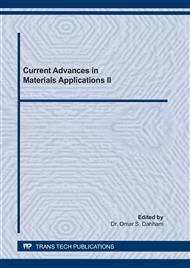[1]
Ibrahim MJ, Mahdy HF, Jailawi RM, Kassir MG, Dawood LM, editors. Hybrid Analytical Hierarchy Process and Continuous Improvement Methodology to Enhance Sustainability: A Case Study on a Beverages Industry. IOP Conference Series: Materials Science and Engineering; 2019: IOP Publishing.
DOI: 10.1088/1757-899x/518/3/032021
Google Scholar
[2]
Sharba MJ, Leman Z, Sultan M. Fatigue life prediction of textile/woven hybrid composites. Durability and Life Prediction in Biocomposites, Fibre-Reinforced Composites and Hybrid Composites. Elsevier; 2019. pp.63-82.
DOI: 10.1016/b978-0-08-102290-0.00004-0
Google Scholar
[3]
Al–Rekabi SH, Al-Wahib A, Sharba MJ, editors. The Use of Nanocomposite Au/Fe2H2O4–GO Based on Surface Plasmon Resonance to Detect Toxic Arsenic (V) in Aqueous Solution. IOP Conference Series: Materials Science and Engineering; 2019: IOP Publishing.
DOI: 10.1088/1757-899x/518/5/052006
Google Scholar
[4]
Patnaik PK, Swain PTR, Purohit A. Selection of composite materials for structural applications through MCDM approach. Materials Today: Proceedings. 2019;18:3454-61.
DOI: 10.1016/j.matpr.2019.07.273
Google Scholar
[5]
Shukla A, Agarwal P, Rana R, Purohit R. Applications of TOPSIS algorithm on various manufacturing processes: a review. Materials Today: Proceedings. 2017;4(4):5320-9.
DOI: 10.1016/j.matpr.2017.05.042
Google Scholar
[6]
Sánchez-Lozano JM, Meseguer-Valdenebro JL, Portoles A. Assessment of Arc welding process through the combination of TOPSIS–AHP methods with fuzzy logic. Transactions of the Indian Institute of Metals. 2017;70(4):935-46.
DOI: 10.1007/s12666-016-0884-x
Google Scholar
[7]
Sharba MJ, Salman SD, Leman Z, Sultan MT, Ishak MR, Hanim MAA. Effects of Processing Method, Moisture Content, and Resin System on Physical and Mechanical Properties of Woven Kenaf Plant Fiber Composites. BioResources. 2015;11(1):1466-76.
DOI: 10.15376/biores.11.1.1466-1476
Google Scholar
[8]
Johri N, Mishra R, Thakur H. Synthesis and Characterization of Jute-and Chicken-Feather-Fiber-Reinforced Polymer Hybrid Composites. Mechanics of Composite Materials. 2019;54(6):821-32.
DOI: 10.1007/s11029-019-9786-4
Google Scholar
[9]
Alaaeddin M, Sapuan S, Zuhri M, Zainudin E, Al-Oqla FM. Polymer matrix materials selection for short sugar palm composites using integrated multi criteria evaluation method. Composites Part B: Engineering. 2019;176:107342.
DOI: 10.1016/j.compositesb.2019.107342
Google Scholar
[10]
Al-Oqla FM, Sapuan S, Ishak M, Nuraini A. A decision-making model for selecting the most appropriate natural fiber–Polypropylene-based composites for automotive applications. Journal of Composite Materials. 2016;50(4):543-56.
DOI: 10.1177/0021998315577233
Google Scholar
[11]
Santiago Ó, Raso MA, Navarro E, Leo TJ. Selection of thermoplastic polymers for use as bipolar plates in direct methanol fuel cell applications. Materials & Design. 2019;183:108148.
DOI: 10.1016/j.matdes.2019.108148
Google Scholar
[12]
Holbery J, Houston D. Natural-fiber-reinforced polymer composites in automotive applications. Jom. 2006;58(11):80-6.
DOI: 10.1007/s11837-006-0234-2
Google Scholar
[13]
Singh B, Garg SK, Sharma SK. Value stream mapping: literature review and implications for Indian industry. The International Journal of Advanced Manufacturing Technology. 2011;53(5-8):799-809. doi:doi.org/10.1007/s00170-010-2860-7.
DOI: 10.1007/s00170-010-2860-7
Google Scholar
[14]
Schmidtke D, Heiser U, Hinrichsen O. A simulation-enhanced value stream mapping approach for optimisation of complex production environments. International Journal of Production Research. 2014;52(20):6146-60.
DOI: 10.1080/00207543.2014.917770
Google Scholar
[15]
Çalışkan H, Kurşuncu B, Kurbanoğlu C, Güven ŞY. Material selection for the tool holder working under hard milling conditions using different multi criteria decision making methods. Materials & Design. 2013;45:473-9.
DOI: 10.1016/j.matdes.2012.09.042
Google Scholar
[16]
Mansor MR, Sapuan S, Zainudin ES, Nuraini A, Hambali A. Hybrid natural and glass fibers reinforced polymer composites material selection using Analytical Hierarchy Process for automotive brake lever design. Materials & Design. 2013;51:484-92.
DOI: 10.1016/j.matdes.2013.04.072
Google Scholar
[17]
Hamidi N, Pezeshki PM, Moradian A. Weighting the criteria of brand selecting in beverage industries in Iran. (2010).
Google Scholar
[18]
Sujito S, Muttaqin WM. Technique for Order of Preference by Similarity to Ideal Solution (TOPSIS) Method for Decision Support System in Top Management. International Journa l of Engineering &Technology (IJET). 2018;7(3.4).
Google Scholar
[19]
Chu J, Su Y. The application of TOPSIS method in selecting fixed seismic shelter for evacuation in cities. Systems Engineering Procedia. 2012;3:391-7.
DOI: 10.1016/j.sepro.2011.10.061
Google Scholar
[20]
Jiang J, Chen Y-w, Chen Y-w, Yang K-w. TOPSIS with fuzzy belief structure for group belief multiple criteria decision making. Expert Systems with Applications. 2011;38(8):9400-6.
DOI: 10.1016/j.eswa.2011.01.128
Google Scholar
[21]
Paul T, Saha A, Majumder H, Dey V, Dutta P. Multi-objective optimization of some correlated process parameters in EDM of Inconel 800 using a hybrid approach. Journal of the Brazilian Society of Mechanical Sciences and Engineering. 2019;41(7):300.
DOI: 10.1007/s40430-019-1805-9
Google Scholar
[22]
Shemshadi A, Shirazi H, Toreihi M, Tarokh MJ. A fuzzy VIKOR method for supplier selection based on entropy measure for objective weighting. Expert Systems with Applications. 2011;38(10):12160-7.
DOI: 10.1016/j.eswa.2011.03.027
Google Scholar
[23]
Gao Z, Liang RY, Xuan T. VIKOR method for ranking concrete bridge repair projects with target-based criteria. Results in Engineering. 2019;3:100018.
DOI: 10.1016/j.rineng.2019.100018
Google Scholar
[24]
Anojkumar L, Ilangkumaran M, Sasirekha V. Comparative analysis of MCDM methods for pipe material selection in sugar industry. Expert systems with applications. 2014;41(6):2964-80.
DOI: 10.1016/j.eswa.2013.10.028
Google Scholar
[25]
Opricovic S, Tzeng G-H. Compromise solution by MCDM methods: A comparative analysis of VIKOR and TOPSIS. European journal of operational research. 2004;156(2):445-55.
DOI: 10.1016/s0377-2217(03)00020-1
Google Scholar


